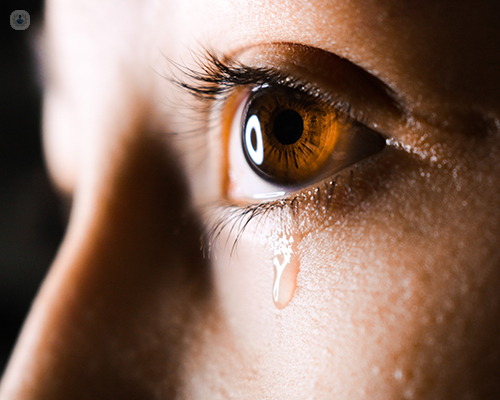No need to cry - strategies for chronically dry, watering and irritable eyes
Autore:Tears are needed for ensuring we can see clearly, and when we don’t have the right balance of tears, or we are not able to drain them correctly, this can result in excessively watery eyes. This can be embarrassing, as it can look like you are crying, and it can disrupt daily visual tasks. If watery eyes are severe, they should be assessed by an ophthalmologist. Miss Vickie Lee, an ophthalmic oculoplastic surgeon and lacrimal specialist, explains how dry and watering eyes can be managed.

What are tears and why do we need them?
Tears are produced by the lacrimal glands and drained away through fine passages at the inner corner of the eyelids into the nose. Tears are essential in keeping the surface of the eye clear, moist and healthy. Blinking spreads the tears evenly across the cornea which acts as the 'windscreen' of the eye to allow us to achieve optimum vision.
What are watery eyes and dry eyes?
The most common cause of excessive tear production (reflex tearing) is caused by dry eye disease (DED). In this case, poor quality tears do not sufficiently wet the cornea and nerve fibres on the surface of the eye send signals to the tear gland to produce more and more tears.
Common causes of under-drainage may result from eyelid problems and/ or the narrowing or blockage of tear drainage channels. A consultation and examination are essential to establish the main causes of watering eyes. If it is likely that there is a tear drainage problem, this will usually involve tear duct syringing to test the patency of the tear drainage system.
Common symptoms of the eyes associated with dry eyes include:
- Irritation
- Redness
- Watering
- Tired-feeling eyes
- Burning
- Itching
- Fluctuations in vision
- Contact lens intolerance
In terms of vision, many with dry eye disease have problems, and a major study of 690 patients with dry eye disease also showed significant problems reading, watching TV, using computers and driving.
Although this condition is not sight-threatening, the correct diagnosis, investigation and management are essential. However, it is an often trivialised condition, even amongst eye specialists, which has resulted in suboptimal management in many patients
How common is dry eye disease?
In large populations, it has been shown to affect 5-30% of those over the age of 50, so in the United Kingdom, this means that millions suffer from dry eyes.
Why is it so common?
Another reason we have seen a dry eye epidemic is due to the explosive rise in people having laser refractive surgery to correct short-sightedness. Estimates indicate that 100,000 procedures are carried out each year in the UK. Resulting dry eye symptoms are thought to occur in more than 50% of cases. This is normally a group of patients who are younger than those who develop dry eyes from the natural ageing process.
What causes watery eyes?
Commonly, watery eyes are caused by dry eye disease. This is because the irritation felt sends signals to the tear glands to secrete more tears. However, if a patient presents with significant watering eyes (i.e. when the tears overflow and cause blurred vision, requiring constant wiping), this suggests that there may also be problems with their tear drainage.
Is there a cure for dry eyes?
Unfortunately, there is no permanent and definitive treatment available for dry eye disease, however, there has been significant scientific progress recently. These advancements have made the symptoms more controllable, improving patients’ quality of life.
What treatments are available?
To determine the right treatment for dry and watering eyes, the cause of the symptoms must first be investigated. For example, watery eyes may be due to dry eye disease, or due to poor drainage. Some patients will require eyelid surgery, whilst others will have minor surgery to enlarge the opening of the tear duct recommended. In severe cases, a tear duct bypass operation known as DCR (dacryocystorhinostomy) may be required to bring the patient relief.
- The TearLab™ system:
This is a diagnostic and treatment tool for patients with dry eye disease and is one of the most used and validated diagnostic devices for this condition. This system allows for a more accurate diagnosis of what is causing dry and watery eyes, hence allowing the correct prescription of treatment to be given.
- Endonasal DCR procedure:
This procedure is carried out from inside the nose, which avoids an external scar. The surgeon can bypass the narrowing or blockage in the tear duct and they join the lining of the tear sac to the lining of the nose. This new passageway is initially kept open using small polythene rods which are removed in an outpatient clinic in the weeks following the procedure. However, this is not always suitable for certain types of tear duct obstruction. The newly made passageways are also kept open with small plastic rods, later removed when the rhinostomy (the join between the tear sac and the lining of the nose) has healed.
- External DCR procedure:
This procedure is performed through a small incision (1.0-1.5cm) on the side of the nose, which allows for the scar to heal optimally. Through this incision, the bypass is created and the polythene tubes passed as above.
Conclusion – how can dry eye disease be managed?
- Careful assessment
- Holistic management
- Treat dry eye and maximise tear drainage


